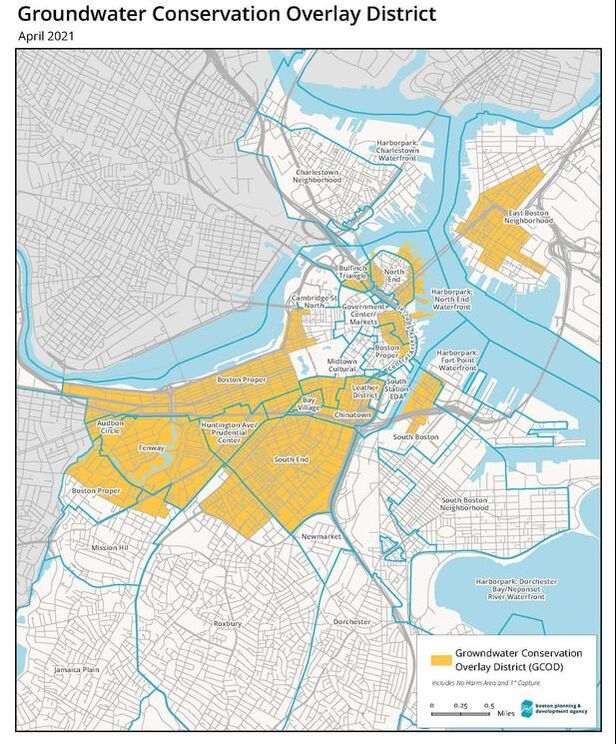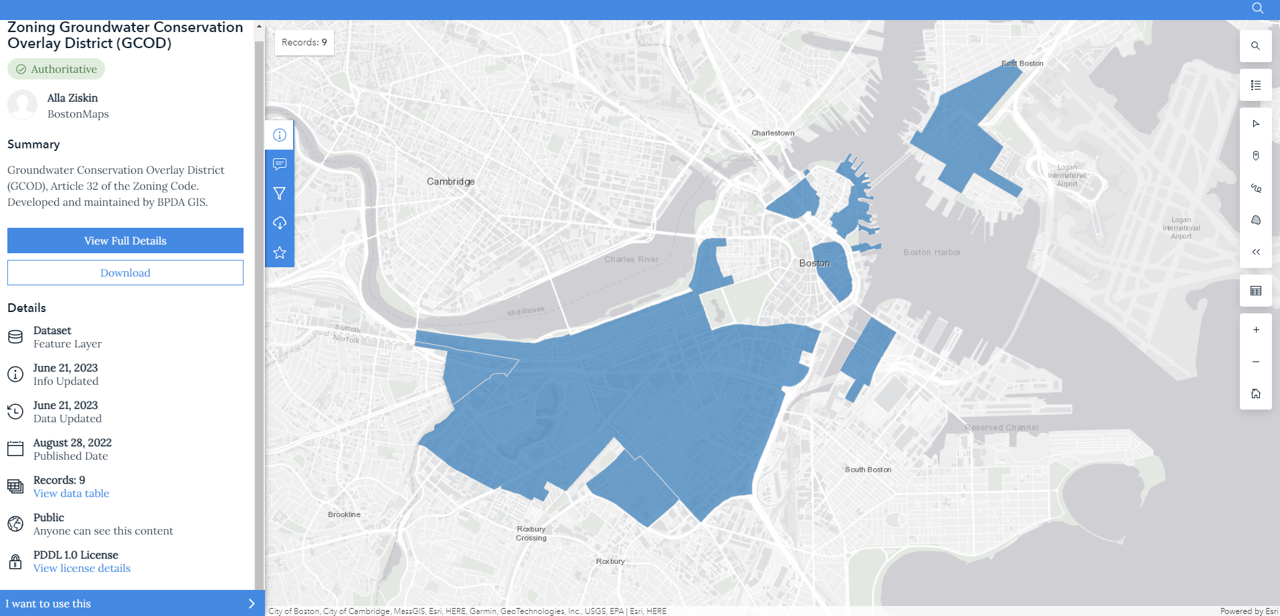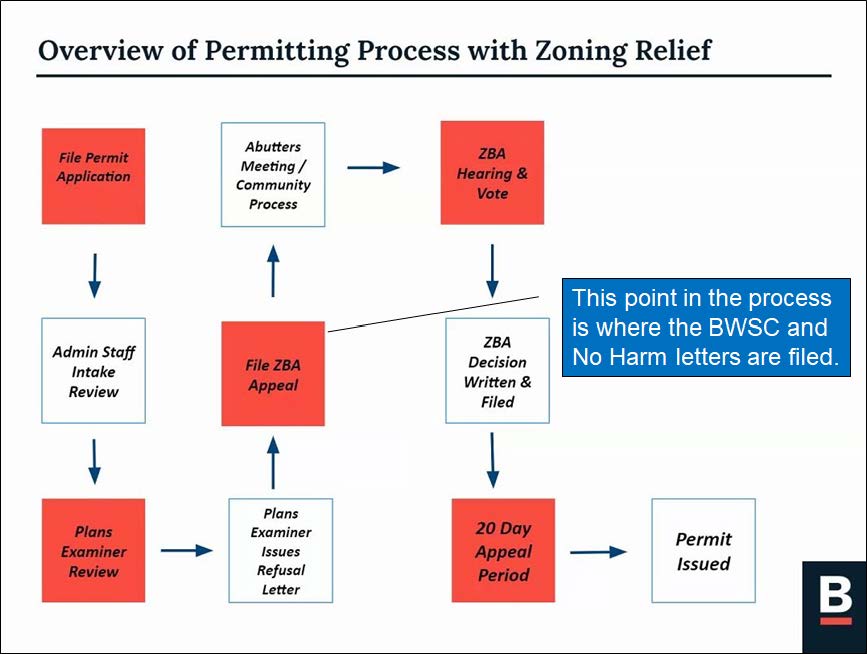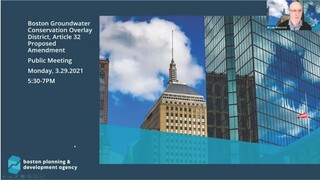GROUNDWATER CONSERVATION
OVERLAY DISTRICT (GCOD), article 32 zoning
The City of Boston adopted a Groundwater Conservation Overlay District (GCOD), Article 32 zoning, in sections of the City to protect wood pile foundations of buildings from being damaged by lowered groundwater levels. The purposes of this article are to:
Not sure if you're in the GCOD? Click on the images below.
Still not sure? Please visit the Boston Water & Sewer Commission (BWSC) GCOD page HERE.
- Prevent the deterioration of and, where necessary, promote the restoration of, groundwater levels in the city of Boston
- Protect and enhance the city's historic neighborhoods and structures, and otherwise conserve the value of its land and buildings
- Reduce surface water runoff and water pollution
- Maintain public safety
Not sure if you're in the GCOD? Click on the images below.
Still not sure? Please visit the Boston Water & Sewer Commission (BWSC) GCOD page HERE.
Any applicant seeking a building permit for a proposed project within the GCOD shall be subject to the requirements of this article where such Applicant seeks:
- The erection or extension of any structure, where such new structure or extension will occupy more than fifty (50) square feet of lot area
- The erection or extension of any structure designed or used for human occupancy or access, mechanical equipment, or laundry or storage facilities, including garage space, if such construction involves the excavation below grade to a depth equal to or below eight (8) feet above Boston City Base (other than where such excavation is necessary for, and to the extent limited to, compliance with the requirements of this article)
- To Substantially Rehabilitate any structure
- Any paving or other surfacing of lot area
Citation for Article 32 requires the applicant to accomplish BOTH of the following items to be deemed in compliance.
Groundwater Recharge System
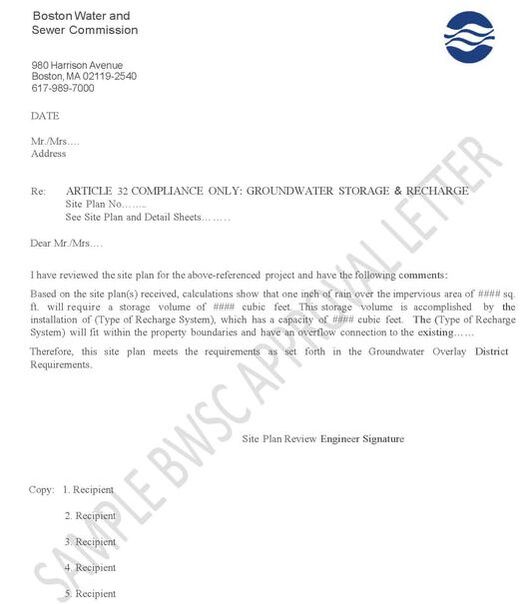 CLICK TO OPEN
CLICK TO OPEN
- The design and installation of a groundwater recharge system capable of capturing 1” of precipitation over the impervious area of the lot.
- The designed system must be submitted to the Boston Water & Sewer Commission (BWSC) for review, comment, and approval.
- For more details on the BWSC site plan requirements please visit HERE.
- Once the system is approved, BWSC will then issue an, “ARTICLE 32 COMPLIANCE ONLY: GROUNDWATER STORAGE & RECHARGE” approval letter.
- A copy of the letter will be provided to the Applicant, the Inspectional Services Department, the Boston Groundwater Trust (BGwT), the Zoning Board of Appeals (ZBA), and the Boston Planning and Development Agency (BPDA).
Certification of No Harm
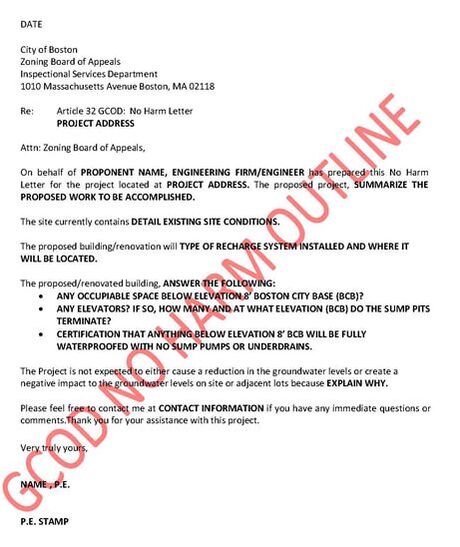 CLICK TO OPEN
CLICK TO OPEN
- The applicant must provide certification that the Proposed Project will result in no negative impact on groundwater levels within the lot in question or adjacent lots.
- The no harm certification is submitted in the form of a letter stamped by a professional engineer registered in Massachusetts.
- The applicant must provide a copy of the no harm letter to the Inspectional Services Department, the Boston Groundwater Trust, the Zoning Board of Appeals.
- If the project is subject to Article 80 review a copy of the no harm letter must be provided to the Boston Planning and Development Agency and the Boston Groundwater Trust.
The certification, together with the drawings and specifications for the Applicant's proposed rainwater infiltration system, shall be submitted by the Applicant with the Applicant's notice of appeal, and it shall state the substance of the facts and opinions upon which it is based and a summary of the grounds for each opinion. In this regard, the Applicant bears the specific burden of demonstrating that the Proposed Project will not result in a negative impact on groundwater levels within the lot or adjacent lots.
An Applicant's compliance with Subsection (a) of this Section 32-6 in itself will not be deemed to be evidence of the Applicant's compliance with Subsection (b) of this Section 32-6.
For more details on filing an appeal with the ZBA please visit HERE.
An Applicant's compliance with Subsection (a) of this Section 32-6 in itself will not be deemed to be evidence of the Applicant's compliance with Subsection (b) of this Section 32-6.
For more details on filing an appeal with the ZBA please visit HERE.
The ZBA will not schedule your hearing date until they have received both the BWSC approval and no harm letters.
For details on the ZBA process please visit HERE.
Once completed both letters are emailed (prior to the ZBA hearing) to ISD at isdboardofappeal@boston.gov and the BGwT at csimonelli@bgwt.org.
For details on the ZBA process please visit HERE.
Once completed both letters are emailed (prior to the ZBA hearing) to ISD at isdboardofappeal@boston.gov and the BGwT at csimonelli@bgwt.org.
For questions or additional guidance please contact Christian Simonelli, Executive Director, at csimonelli@bgwt.org.
|
January 13th, 2021
Boston City Council Meeting on Order for a hearing regarding potential zoning amendments to be proposed by the BGwT (Testimony begins at 3:06:20) April 15th, 2021
BPDA Board of Directors Meeting: Article 32 Proposed Amendments (Testimony begins at 55:46) Supporting Documentation Link |
February 19th, 2021
Committee on Planning, Development, & Transportation Docket#0181-Potential zoning amendments to be proposed by the Boston Groundwater Trust May 13th, 2021
BPDA Board of Directors Meeting: BPDA Board voted to expand the Groundwater Conservation Overlay District (GCOD) Article 32 with testimony (Testimony begins at 1:21:25) Supporting Documentation Link |
March 29th, 2021
Boston Groundwater Conservation Overlay District Article 32 Proposed Amendment Public Meeting (Testimony begins at 8:15) |
